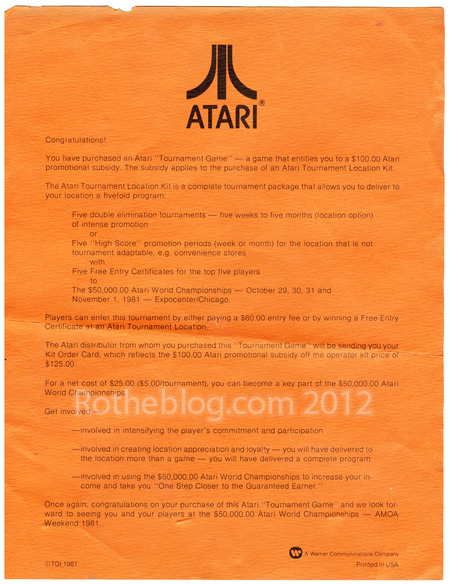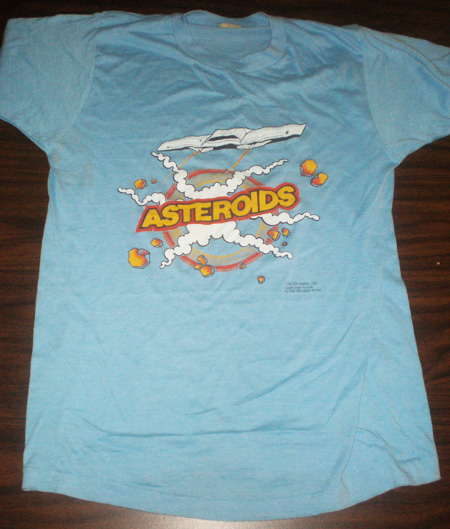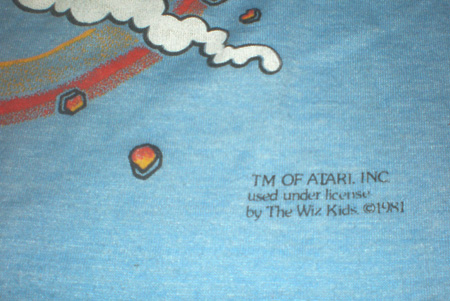Atari could have revolutionized social gaming in 1981
In late 1981 Atari conducted a ‘World Championship’ event at the Expocenter in Chicago. If you aren’t familiar with the history of this event, a quick Google search will turn up a number of items online. This article is probably the best.
Rife with mismanagement, shady dealings and lost profits, the championship event is widely considered to be a colossal failure – not ET Atari 2600 bad, more like Pac-man bad.
But why did this event flop so hard? Atari was part of Warner Communications – a tremendous distribution asset. They had Lee Peppard, who would appear to have had some cursory success in event promotion. They had a number of things working in their favor, including the brand recognition and consumer base.
There is at least one key area where Lee Peppard / Atari obviously failed…
Reasons why the Atari World Championships failed
This past September, I got to talk to a player that was involved with the World Championship event in Chicago. Dave Watts lives locally here in Indianapolis. Now in Zionsville, Dave used to play a little bit of Asteroids and Asteroids Deluxe. Dave said that he would call into Twin Galaxies when he achieved a new million point score, but his arch nemesis would always be one game ahead of him (Scott Safran? Leo Daniels?).
Regardless, Dave was probably the best Asteroids player in the Indianapolis area.
A Carmel IN arcade participated in the World Championship promotion, tracking Dave’s score where he eventually won an ‘Atari Qualifier’ (hotel, bus ticket and entry). And…he got this neat letter, and possibly this tshirt (given that it is different then the widely known $50K Atari Championship shirt, which he gave to me when I purchased his trailer full of games in September.
The way Dave tells the story, is insightful into how well the promotion was run.
Dave attended the event in Chicago, excited to go head to head with other top notch players in Asteroids. He did have any idea that he would be playing on Centipede, a game he neither liked nor had developed any gameplay skills.
If Lee Peppard had planned his return on promotional efforts around revenues from entry fees, is Dave’s memory accurate that he got an expense paid trip?
Additionally, Why were the amount of entrants so low per kit?
This kit may have been for five entrants, from a tournament local to region, but if the goal was to move towards a forecasted amount of 3,000 entrants, why not make the barriers to entry even lower?
This post will pose a number of questions, of which I don’t have factual answers. Anyone familiar with the event, a former Atari employee, or arcade owner or operator have any insight – please contact me with some more detail. Here are my top three suggestions that should have been considered.
1. Recognized, preferred gaming locations
Pick qualifying locations in major markets. This is how a tournament should work. Drive serious players / parents to those locations. Drive up demand.
Deepen the partnerships with those locations by spending some of that $100K in advertising (that may have taken place in the regional Chicago market) and leverage the distribution capabilities of Warner Communication. Granted, $100K wouldn’t go very far, but let’s dream big. 3,000 players nation wide? That seems like a tiny portion of the overall audience. Maybe it was a pilot program, to scale it out to other markets. Who knows.
2. Give more money to more players
The 80/20 rule. If you want volume of attendees, then structure the tournament to appeal to the 80% of the average players. Survey data to answer the simplest questions from your preferred locations – how long does it take to achieve a score, how many players are at a score tier, and how much much money it takes to hit that tier.
Ensure the players spend the money at the locations. Inspire them to practice to reach a tier within their reach – with the promise of taking part in something ‘bigger than themselves’…and the money is nice too. Require the locations to have a couple of dedicated machines to the tournament (for tracking)
3. Diversify revenue model
Would a preferred location buy additional air time in a regional market through Warner to build their location? With the lower barrier to potential success, require players pay to enter the tournament and profit share with locations. Drive operator purchase of machines through clear communication of the tournament machines, and then include advertising of where pre-selected operators have machines placed on site.
Atari’s Legacy
I’ve consumed my fair share of information on Atari over the years. The company made some smart moves, and had some huge blunders in an industry that was blossoming. It may be trite to reflect on that period and make a summary that a lack of strong, visionary leadership was the cause for their mistakes.
From what little I’ve read about the tournament online, it just seems like it was not well planned. It feels like Atari, on a whim, threw $40K at Lee Peppard and just assumed that promotional success carried over from Fooseball to video games.
There is no mention that a liaison, who knew the behaviors of the consumer or the needs of the location manager, was involved in any capacity.
Atari should have made good money from a Championship event. The brand / platform was there. There may have never been a need for Twin Galaxies.
What a huge opportunity for Atari to be on the forefront to develop the interactive, social component of gaming – Connecting a national audience pre-internet, that is just expected in gaming today.
Such a sad, missed opportunity.
Again – would love to hear from the former arcade location in Carmel IN that was an official partner in this Atari World Championship event from 1981. If you were the location operator, or remember the location name or any information please contact me.
Here are some similar arcade posts
- Pengo High Score!
- Play arcade games in Broad Ripple
- Pengo High Score – 347,430
- Agent X / Cloak Dagger Jacket
- 18 Arcade Games in a trailer in Zionsville
If you enjoyed this post, please consider to leave a comment or subscribe to the feed and get future articles delivered to your feed reader.
Comments
A few years back I purchased a pinball machine at an auction. No one else seem to have had any interested in the machine besides me and one other bidders. It’s a collector’s item indeed. It was manufactured back in 1931 by a fella named David Gottlieb. The the machine is called “Gottlieb’s Baffle Ball”.
This machine model was a first if it’s kind, and very legendary during the early coin-operated era. History tells us that in 1939 this gem sold for only $17.50. The machine can be (manually) set to dispenses five to seven balls for only a penny. WOW!
My problem is the right flipper. It’s very weak and may need some minor repairing. I’m afraid to open it up and investigate. Who should I contact or trust to maintenance such a valuable treasure? Somebody Please Help!!!!
Just an addition – he would not have gotten the letter as a result of the qualifier. That’s the letter that came with the competition kit given to the arcade owners regarding their kit. Had nothing to do with the competitors. It is possible he asked the owner for the kit letter as a souvenir. The shirt is not a competition shirt, it’s a shirt that was sold in department stores, etc. at the time (I have one as well). Wiz Kids was just a licencor of arcade properties for t-shirts at the time. They did a Pac-Man one as well for instance (http://www.ebay.com/itm/Pac-Man-The-Wiz-Kids-T-Shirt-Size-small-34-36-/110982241019?nma=true&si=1sffhFwlEGt7D48ygKQeu%2BVLOcY%3D&orig_cvip=true&rt=nc&_trksid=p2047675.l2557).
Leave a comment
Your email address is never displayed and cannot be spammed. If your comments are excessively self-promotional you will be banned from commenting. Read our comment privacy policy.






November 29, 2012
I am the author of the blog post you referenced.
I went back and checked one of my two major sources – the January 1, 1982 issue of Play Meter and found some more info that might be helpful.
The person on the Atari end who appears to have done most of the work on this was Frank Ballouz (coin-op marketing VP). He was actually at the tournament.
Peppard’s tournament director was Ed Tuhkanen. Peppard claimed that the whole high-score qualifcation thing was a last minute idea by Tuhkanen when they saw the low turnout. The article, however, points out that those rules were in print and distributed several hours before the tourney started.
According to this article, Atari actually fronted Peppard $50, 000 (the amount of their prize pool).
They also say that Ballouz expected 2,000 players from the Chicago area alone.